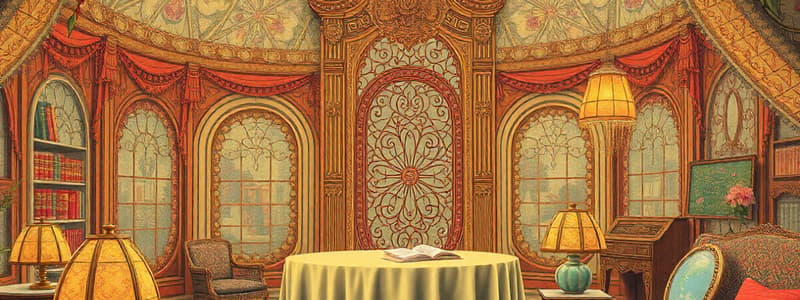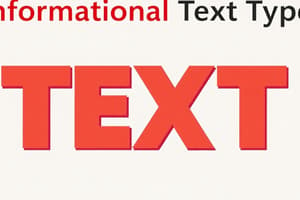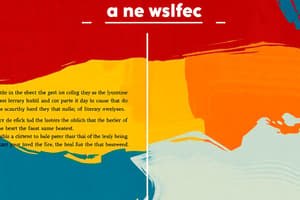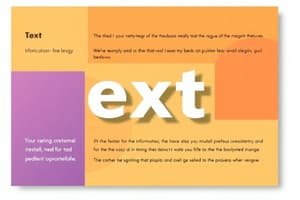Podcast
Questions and Answers
Events in informational texts with a chronological structure are arranged in the order in which they happened.
Events in informational texts with a chronological structure are arranged in the order in which they happened.
True (A)
A descriptive text structure primarily relies on statistical data and numerical evidence to convey information.
A descriptive text structure primarily relies on statistical data and numerical evidence to convey information.
False (B)
Informational texts using a compare and contrast structure highlight both the resemblances and disparities between two or more subjects.
Informational texts using a compare and contrast structure highlight both the resemblances and disparities between two or more subjects.
True (A)
In a problem and solution text structure, the resolution is typically presented before the identification of the issue.
In a problem and solution text structure, the resolution is typically presented before the identification of the issue.
Social contract theory was developed by John Locke and argued that government itself is a contract between the masses and their leaders.
Social contract theory was developed by John Locke and argued that government itself is a contract between the masses and their leaders.
Literary nonfiction integrates factual information with stylistic devices commonly found in fictional works.
Literary nonfiction integrates factual information with stylistic devices commonly found in fictional works.
The Declaration of Independence, drafted by Thomas Jefferson, was signed on July 2, 1788.
The Declaration of Independence, drafted by Thomas Jefferson, was signed on July 2, 1788.
Diaries are generally intended for widespread distribution and publication to a broad audience.
Diaries are generally intended for widespread distribution and publication to a broad audience.
Drafted in 1787 and ratified in 1788, the Articles of Confederation outlines the powers of the government.
Drafted in 1787 and ratified in 1788, the Articles of Confederation outlines the powers of the government.
The first ten amendments to the U.S. Constitution are known as the Bill of Rights.
The first ten amendments to the U.S. Constitution are known as the Bill of Rights.
The Mayflower Compact's central goal was to establish a system for self-governance among the Pilgrims.
The Mayflower Compact's central goal was to establish a system for self-governance among the Pilgrims.
Narrative history focuses on current events and breaking news stories, presented in a storytelling format.
Narrative history focuses on current events and breaking news stories, presented in a storytelling format.
President Abraham Lincoln delivered the Gettysburg Address on November 19, 1873.
President Abraham Lincoln delivered the Gettysburg Address on November 19, 1873.
Issued January 1, 1863, the Emancipation Proclamation granted freedom to all slaves living in the United States.
Issued January 1, 1863, the Emancipation Proclamation granted freedom to all slaves living in the United States.
Henry David Thoreau refused to pay his income tax as a form of civil disobedience.
Henry David Thoreau refused to pay his income tax as a form of civil disobedience.
Flashcards
Cause and Effect Structure
Cause and Effect Structure
A text structure that explains how events are connected as causes and effects.
Compare and Contrast Structure
Compare and Contrast Structure
A text structure that highlights similarities and differences between two or more things.
Chronological Order Structure
Chronological Order Structure
A text structure that presents events in the order they happened.
Problem and Solution Structure
Problem and Solution Structure
Signup and view all the flashcards
Descriptive Structure
Descriptive Structure
Signup and view all the flashcards
Literary Nonfiction
Literary Nonfiction
Signup and view all the flashcards
Expository Essay
Expository Essay
Signup and view all the flashcards
Mayflower Compact
Mayflower Compact
Signup and view all the flashcards
Social contract theory
Social contract theory
Signup and view all the flashcards
Declaration of Independence
Declaration of Independence
Signup and view all the flashcards
Articles of Confederation
Articles of Confederation
Signup and view all the flashcards
U.S. Constitution
U.S. Constitution
Signup and view all the flashcards
Gettysburg Address
Gettysburg Address
Signup and view all the flashcards
Emancipation Proclamation
Emancipation Proclamation
Signup and view all the flashcards
Civil Disobedience
Civil Disobedience
Signup and view all the flashcards
Study Notes
Informational Text Structures
- Informational texts use various structures
- Cause and effect: Shows how actions lead to events
- Compare and contrast: Highlights similarities and differences
- Chronological order: Presents events in order of occurrence
- Problem and solution: Outlines a problem and its resolution
- Descriptive structure: Uses vivid language to depict an event
Literary Nonfiction
- Literary nonfiction (creative nonfiction) combines factual information with fictional writing techniques
- Includes elements like plot, setting, characters, imagery, figurative language, and tone
- Includes various types of literary nonfiction:
- Nonfiction essays: Expository, personal, or persuasive, usually brief and single-topic focused.
- Personal narrative nonfiction: Author's experiences, including autobiographies, memoirs, diaries, journals, letters, and biographies (third-party).
- Science writing: Scientific facts and principles presented creatively.
- Narrative journalism: Current events, travel, sports, and food in an informal narrative style.
- Narrative history: Historical events presented in a storytelling format.
American History Key Documents & Events
- Mayflower Compact (1620): Established self-governance and legal order.
- Social Contract Theory (17th century): Agreement between people and leaders. Basis for American Revolution.
- Declaration of Independence (1776): Declared American independence from Britain.
- Articles of Confederation (1777): America's first constitution, outlined state-federal relations.
- U.S. Constitution (1787): Outlines government powers, first 10 amendments are the Bill of Rights.
- Gettysburg Address (1863): Famous speech by President Lincoln at the Battle of Gettysburg.
- Emancipation Proclamation (1863): Granted freedom to slaves in Confederate states.
Civil Disobedience (1849)
- Henry David Thoreau's essay “Civil Disobedience”: Described Thoreau's jail time for protesting slavery and governmental spending.
- Thoreau's background: Part of a liberal abolitionist family, influenced by Transcendentalism (individualism, spirituality, self-reliance, opposition to material wealth).
- Civil Disobedience concept: Non-violent protest against injustice; advocated for tax refusal as protest.
- Influence: Inspired movements and leaders resisting injustice, including Mahatma Gandhi and Martin Luther King Jr.
Reading Artistic Media
- Visual media includes artworks, movies, and photos
- First step: Notice literal content (what is visibly present)
- Second step: Analyze artistic choices (color, composition, materials, camera angles) – how those choices impact understanding of the subject and the artist's message.
- Third step: Examine context (title, historical background) to gain deeper interpretations
- By considering visual choices and context, viewers can fully understand the artwork's message.
Studying That Suits You
Use AI to generate personalized quizzes and flashcards to suit your learning preferences.




